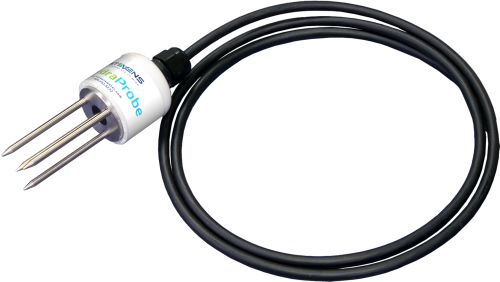






Overview
HydraProbe is a rugged soil sensor with patented technology that provides continual, consistent accuracy measuring the three most significant soil parameters simultaneously—moisture, salinity and temperature.
Read MoreBenefits and Features
- Patented technology that accurately measures moisture and electrical conductivity permits more accurate optimization of watering and fertilization than with just moisture
- Continual, long-term data without calibration
- Durable stainless steel tines, fully potted components, compact sealed design and a 5-year warranty
- Digital sensor using the SDI-12 protocol—no setup, just connect to data logger. Compatible with any SDI-12 capable data logger
Images



Detailed Description
The Science Behind HydraProbe
HydraProbe is a “dielectric impedance”-based sensor developed by the physics department at Dartmouth College. Unlike capacitance or time domain based soil sensors, HydraProbe fully characterizes the dielectric spectrum using a radio frequency at 50 MHz.
Complex mathematical computations performed by an onboard microprocessor process the reflected signal measurements to accurately determine the soil’s dielectric permittivities, the key parameters behind the soil moisture and bulk EC measurement.
Low inner-sensor variability means there is no need for sensor-specific calibrations.This method has passed the most rigorous scientific peer review from dozens of journals such as the Vadose Zone Journal, American Geophysical Union, and The Journal of Soil Science Society of America.
Read more about the different soil sensor technologies at soilsensor.com
About EC (Electrical Conductivity / Salinity)
- The bulk EC (electrical conductivity) of the soil is correlated to the soil’s salinity because salts when mixed with water will conduct electricity. The bulk EC parameter is sometimes called “salinity”.
- Many nutrients are salts—a source of salinity. Nutrient accumulation, poor drainage and saline irrigation water can lead to the unwanted buildup of salinity in soil.
- High bulk EC can affect moisture readings and create errors with capacitance based moisture sensors. HydraProbe’s soil moisture measurement is less sensitive to salinity than other capacitance based probes.
- The soil bulk EC can change dramatically with water content and can be affected by the quality of the irrigation water, fertilization, drainage, and other natural processes.
- Compaction, clay content and organic matter, can influence moisture holding trends over time, also affecting bulk EC capacities in soil.
- The effect of bulk EC on the moisture availability to a plant’s roots is great. As salinity changes the water needs also change.
- A temperature corrected bulk EC parameter is available so the user can make comparison independent of soil temperature.
- Because HydraProbe also measures the dielectric permittivities, algorithms can be applied to approximate the EC of the soil pore water allowing for better soil salinity characterizations.
Specifications
| Real Dielectric Permittivity | Accuracy: ± 1.5% or 0.2 whichever is typically greater. Range: 1 to 80 where 1 = air, 80 = distilled water. |
| Soil Moisture | Accuracy: ± 0.01 WFV for most soils ± 0.03 max for fine textured soils*. Range: From completely dry to fully saturated. *Accuracy may vary with some soil textures. |
| Bulk Electrical Conductivity | Accuracy: ± 2.0% or 0.02 S/m whichever is typically greater. Range: 0.01 to 1.5 S/m. |
| Temperature Accuracy | ± 0.3°C |
| Temperature Range | -10°C to +60°C *Extended temperature range sensor (-40°C to +60°C) available. |
| Inter-Sensor Variability | ± 0.012 WFV (θ m3 m-3) |
| Power Supply | SDI-12: 9-20 VDC. RS-485: 9-20 VDC. |
| Power Consumption: | SDI-12: <1 mA idle / 10 mA active. RS-485: <10 mA idle / 30 mA active. |
| Available Cable Lengths | SDI-12: 7.62 m (25 ft.) and 15.24 m (50 ft.) |
| Baud Rate | SDI-12: 1200. RS-485: 9600 |
| Communication Protocol | SDI-12: standard v.1.2. RS-485: custom or open spec |
| Addressing | Serial; allows multiple sensors to be connected to any RS485 or SDI-12 data logger via a single cable. |
| Operating Temperature Range in Soils | Freezing to +60°C |
| Standard Temperature Probe Range | -10°C to +60°C |
| Extended Temperature Probe Range | -40°C to +65°C *”Extended Temperature Range” version available, which can measure down to -40°C for research, cold-climate, high-altitude, arctic applications or any other measurement situation where there will be significant below-freezing ground temperatures. |
| Storage Temperature Range | -40°C to +65°C |
| Water Resistance | Tolerates continuous full immersion |
| Cable |
|
| Vibration & Shock Resistance | Excellent; potted components in PVC housing and 304 grade stainless steel tines |
| Length | 4.9” (124 mm) |
| Diameter | 1.6” (42 mm) *Optional slim housing version available: 1.4” (35.8 mm) |
| Weight | 7 oz. (200 g) *Optional slim housing version available: 6.5 oz. (184 g) |
| Cable Weight | 0.86 oz/ft (80g/m) |
| Sensing Volume | Length: 2.2” (5.7 cm) Diameter: 1.2” (3.0 cm) |
| Sensors | Not interchangeable |
| Measurements Made | Real Dielectric Permittivity (isolated), volumetric water content for inorganic & mineral soil, bulk electrical conductivity, soil temperature |
| Water Content Accuracy | ± 0.01 WFV for most soils ± 0.03 max for fine textured soils |
| Required Equipment | Measurement System |
| Soil Suitability | Short rods are easy to install in hard soil. Suitable for soils with higher electrical conductivity. |
| Rods | Replaceable |